Aramaic Project No. 120 to 111 - Interviews and Performances - Video List
No. - [120] [119] [118] [117] [116] [115] [114] [113] [112] [111]| Aramaic Project Number | Description | Duration | Date and place of Recording | Video |
| "120 | Who is the real founder of the CMI Congregation ? The INCONVENIENT TRUTH Dr. Thomas Konnammakkal, an intellectually honest scholar and philosopher, argues that Palackal Thoma Malpan (1780-1841) is the founder of the Carmelites of Mary Immaculate (CMI). Fr. Koonammakkal builds his thesis on a key phrase from the Chronicles of Saint Kuriakose Elias Chavara (1805-1871) കൊവേന്തയുടെ തുടക്കം (Malayalam, “the starting/founder of the Monastery/Congregation”), in reference to Palackal Thoma Malpan. Thoma Malpan was Saint Chavara’s preceptor at the Seminary at Pallippuram. The most important duty of the preceptor in those days was to teach Syriac language and liturgy. The teaching of scripture, theology, and philosophy went along with it. Saint Chavara held his guru in high esteem. The saintly Thoma Malpan, in turn, treated his precocious protégé like an adopted son. St. Chavara came to the family of Thoma Malpan at the age of 12 and joined the seminary at the age of thirteen. After priestly ordination, St, Chavara assisted in realizing the long-cherished dream of his venerable guru to establish an indigenous religious Congregation for men among the St. Thomas Catholics who, at that time, were under the ecclesiastical jurisdiction of foreign prelates of the Roman Catholic Church. During his later years, St. Chavara, who became a Malpan (teacher/scholar of the Syriac language) and poet in the Malayalam language, decided to write a chronicle of events in his life and that of the Congregation. Following the advice of his spiritual father, a foreign missionary, Saint Chavara incorporated a biography of his guru in the Chronicle. The phrase mentioned above appears in the final paragraph of the bio where the author describes the death and burial of Palackal Malpan. St. Chavara unequivocally acknowledges that his guru is the founder of the religious congregation of which he became the very first professed member and superior. In this video, Fr. Koonammakkal challenges the superiors of the CMI congregation to revisit the history with greater intellectual honesty and integrity. See also Aramaic Project-106 Joseph J. Palackal, CMINew York 13 February 2019 |
12:55 | August 3, 2014 Beth Aprem Nazrani Dayra, Kuravilangad |
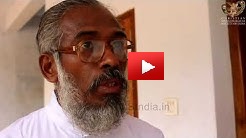 |
| 119 | Solemn Syriac Qurbana . Fr. Probus Perumalil, CMI. A musical treasure This recording is a musical treasure and valuable addition to our Aramaic Project archive. It can serve as a reference point for historians of Syriac liturgy, Indian Christianity, and Kerala culture. Also, the recording contains a vast body of melodies and several examples of performance practices that can be a resource for musicologists who work on inter and intra-cultural musical borrowings. What we have here is a pre-1962 version of the solemn Qurbana in Syriac, which contains the Syriac translation of a few chants borrowed from the Roman Catholic (Latin) tradition. It is possible that Bishop Francis Roz, S. J. (1559-1624) mediated this inter-ritual borrowing, after the Synod of Udayamperoor (1599). Some of the melodies use rhythmic patterns that are popular in South Indian classical music; this may indicate that someone in Kerala composed these melodies. If that be the case, these melodies should find a place in the academic discourse on Indian and Indian Christian music. Fr. Probus Perumalil (1922-2009) made this recording sometime in the 1970s, in the context of a dry mass that he celebrated at the private chapel of St. Joseph’s Monastery at Mannanam, in the Kottayam district of Kerala. St. Joseph’s Monastery (est. 1831) is the mother house of the Carmelites of Immaculate (CMI). It was on the premises of this Monastery that Saint Kuriakose Elias Chavara (1805-1871), the protégé of the saintly Palackal Thoma Malpan (1780-1841; my collateral ancestor) established the first printing press in Kerala with facilities to print East-Syriac texts. Subsequently, the CMI priests and lay-brothers played a significant role in preserving the Syriac heritage of the Syro Malabar Church. Fr. Probus Perumalil, CMI (1922-2009), a gifted singer of Syriac chants, took the initiative to make this recording with the help of the church musicians of St. Joseph’s Monastery. Fr. Probus, who grew up in the Syriac tradition, had a unique vocal inflection of the Syriac texts and melodies that resulted from the extended use of the language from his early formative years. The recording also represents the CMI style of singing Syriac chants, which, the diocesan priests in Kerala would characterize as stylistically different from theirs. Even after the vernacularization of the Syro Malabar liturgy (1962), Fr. Probus continued to be a well-sought-after celebrant of solemn Syriac Qurbana on such special occasions as the celebration of the principal feast of the patron saint of Syro Malabar parishes, mostly in the southern parts of Kerala. I got acquainted with Fr. Probus in the late 1970s and soon became aware of his unique talent as a singer of Syriac chants. In 1999, when I worked on a commercial release of a selection of Syriac songs of the Syro Malabar Church, I requested Fr. Probus to be the lead singer. Thus, the CD, “Qambel Maran: Syriac Chants from South India” (PAN Records, Netherlands, 2002; became a permanent record of the unique vocal inflection of Fr. Probus as well as his memory of many Syriac melodies from the liturgical context other than Qurbana ( the current recording is a worth while supplement to that CD). Earlier, in the 1980s, Fr. Probus and I discussed the possibility of making a studio recording of his solemn Syriac Qurbana. That plan did not materialize. Knowing my disappointment, Fr. Probus shared the audio cassette of this recording. I carried it with me in the subsequent years during my sojourn at various locations in India and the USA. Fr. Probus spent his retirement years at his favorite place, the St. Joseph’s Monastery at Mannanam, and is buried at the Monastery chapel. The Christian Musicological Society of India is immensely grateful to Fr. Probus for handing down this intangible treasure of Indian Christianity. May he continue to use his voice to sing the Trisagion in Syriac with angels in heaven. We gladly present this recording as an offering to the lovers of Syriac music, church history, and Eastern-Catholic culture around the world. All in all, this may be the most valuable archival material we have so far. New York6 February 2019 Copyright 2019: Joseph J. Palackal |
1:17:30 |
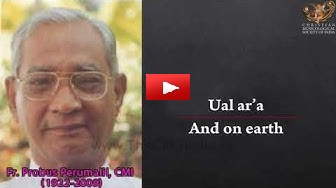 |
|
| AP 119A | A different way of singing Qandisa Alaha (pre 1962 Missal). Fr. Perumalil CMI A different Performance practice (manner of executing a melody) of Qandisa Alaha. From the solemn Qurbana (pre-1962 missal) of Fr. Probus Perumalil, CMI (1922-2009). Recorded at St. Joseph's Monastery Chapel, Mannanam, Kerala, India. Early 1980s. See the full video at During the Syriac era, talented priests with the help of local choirs designed the performance practice of chants. The use of music notation, Indian or Western, was not prevalent. People seemed to have appreciated the expertise of celebrants and choirs in improvising existing melodies. Fr. Probus Perumalil, CMI was a celebrated singer of Syriac chants. He participated in the recording for the first commercial CD of Syriac Chants (PAN records, Netherlands, 2002). Fr. Probus made a private recording of the solemn Qurbana at my request. This recording has become a musical treasure; it sheds light on the musical practices of a particular period in the history of liturgy and music in India. We are posting several similar segments to help future scholars to make a comparative study of particular chants. We hope these videos will motivate prospective researchers to take Christian music in India a worthwhile topic of study. Reference: Fr. Probus Perumalil, CMI http://www.thecmsindia.org/personalit... Joseph J. Palackal, CMI |
4:10 | Recorded at St. Joseph's Monastery Chapel, Mannanam, Kerala, India |
 |
| 118 | Dr. Joseph J.Palackal, CMI introduces Syriac chants at his native parish. Note: It was indeed an honor for me to get an opportunity to be the celebrant for the solemn Qurbana on the day of the principal feast of my native parish, the Assumption of the Blessed Virgin, on August 15 (2018). It is all the more honorable because; the main altar of this church is also the resting place of the saintly Palackal Thoma Malpan (1780-1841), my collateral ancestor. The Malpan is the founder of the first seminary of the St. Thomas Catholic community that is currently known as the Syro Malabar Church. Standing on the altar, the celebrant can see the Seminary on the upper floor. Not only that, the Malpan’s protégé, Saint Kuriakose Elias Chavara (1805-1871), who spent several years at the Pallippuram Seminary. For a long time I wanted to introduce Syriac chants at this parish, where, once upon a time, Syriac chants reverberated among its walls. The video shows my attempt and the positive response of the congregation. Glad to say that my niece, Shalini Rosa Kurian, was one of the lead singers, who already knew the melodies. Joseph J. Palackal, CMINew York 5 February, 2019 |
11:00 | August 15, 2018 St. Mary's Forane Church, Pallipuram |
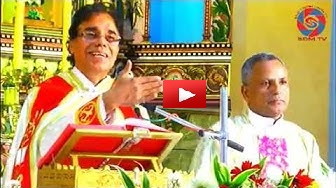 |
| 117 | Fr. Augustine Kandathikudilil, "The Syriac language, a connecting link." Note: Fr. Augustine Kandathikudilil had the privilege of learning the Syriac language as well as Syriac melodies of the solemn Qurbana from a great priest, teacher, and talented singer, Fr. George Plathottam. Fr. Augustine also imbibed the zeal to promote the East Syriac heritage of the Syro Malabar Church. Fr. Augustine celebrates Solemn Qurbana in Syriac occasionally. Fr. Augustine teaches Syriac melodies to the Sunday school children in his parish. He thinks that continuing the Syriac tradition is a service to the future of the Syro Malabar Church, which is growing fast outside Kerala. According to Fr. Augustine, the Syriac language can be a connecting link to Syro Malabar communities around the world that celebrate the same liturgy in their respective native tongues and musical styles. Let us hope the Syro Malabar hierarchy will someday latch on to that idea and take steps to promote the Syriac language and music. Joseph J. Palackal, CMINew York 30 January 2019 |
16:47 | July 30, 2018 St. Mary's Forane Church, Thazhathupally, Kaduthuruthy |
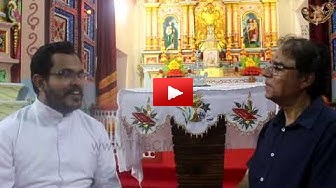 |
| 116 | Mebin John (Rooha Media), on a mission to promote the Syriac heritage Note: It was indeed a pleasure to speak to Mebin John, who is passionate about promoting the Syriac heritage of the Syro Malabar Church. Mebin acquired an interest in the Syriac language and liturgy early on when he was a young boy. Although not a singer, Mebin was mesmerized by the Syriac melodies that he listened to occasionally in his parish church. Later, he decided to know more about the liturgy and decided to promote Syriac chants through social media. The online Syriac chant competition that he organized in 2018 received great acclaim. Entries, mostly from youngsters, came from the Syro Malabar communities around the world. We look forward to more contributions from Mebin in the coming years and pray for God's blessings on him and his family. Joseph J. Palackal |
13:17 | July 30, 2018 St. Mary's Forane Church, Thazhathupally, Kaduthuruthy |
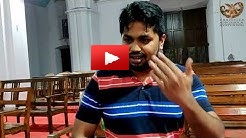 |
| 115 | Syriac words in Malayalam prayer vocabulary: Antony & Elamma Pathinaril Antony and Elamma Pathinaril recite the Angelus and Our Father in Malayalam. These prayers include several Syriac words (in their East-Syriac/Chaldean pronunciation). The video sheds light on the liturgical practices until the middle of the twentieth century. Syro Malabar Catholics were at home with these Syriac words which linked their history to the early Christian era. We are thankful to Dr. Martin Antony for organizing the recording of this video. Antony and Elamma are Dr. Martin's parents. The video may be of Joseph J. Palackal, CMIinterest to scholars on the history and development of the Malayalam language. Syriac words in these prayers: Slīwā = Holy Cross Bāwā = Father/parent Ruhā d’qudšā = breath of holiness/Holy Spirit Mālākā = messenger/angel Ummā = mother Marth Maryam = Lady Mary/Blessed Virgin Mary Īšō Mšīhā = Jesus the Messiah Joseph J. Palackal, CMI New York 23 January 2019 |
6:11 | July 31, 2018 Residence of Antony and Elamma Pathinaril,Pakalomattom,Kottayam |
 |
| 114 | The Syriac translation of the Latin chant "Gloria" This video takes us to a particular era in the history of Syriac chants and liturgy in South India. The Portuguese missionaries introduced some of the Latin-rite practices in the Syro Malabar liturgy. The singing of “Gloria,” during the liturgy of the Word, was one of them. Probably, Bishop Roz, S. J.(1559-1624), the first bishop of the St. Thomas Catholics, did the translation (the Bishop knew Syriac and Malayalam). The chant went of use in 1962 when the Syro Malabar Church vernacularized its liturgy. The revised liturgy did not include Malayalam translation of the Gloria. Syriac choirs from the period of transition do remember the melodies. We have a few recordings of this chant that are still on the editing table. In this video, Fr. Kalayil hints at a melody that Fr. Sylvester Thattil, CMI composed. Fr. Kalayil recalls that this melody was part of the celebration of Qurbana during the Syriac era. It also means that there were many compositional activities in Kerala during that era. Future historians of the Syriac music and liturgy in Kerala may have to take note of this piece of information. Fr. Albert Saldanha, S. J.(1896-1975, This video takes us to a special era in the history of Syriac chants and liturgy in South India. The Portuguese missionaries introduced some of the Latin-rite practices in the Syro Malabar liturgy. The singing of “Gloria” was one of them. Probably, Bishop Roz, S. J., the first bishop of the St. Thomas Catholics made the translation (the Bishop knew Syriac and Malayalam). The chant went of use in 1962 when the Syro Malabar Church vernacularized its liturgy. The revised liturgy did not include Malayalam translation of the Gloria. Syriac choirs from the period of transition do remember the melodies. We have a few recordings of this chant that are still on the editing table. In this video, Fr. Kalayil hints at a melody that Fr. Sylvester Thattil, CMI composed. Fr. Kalayil recalls that this melody was part of the celebration of Qurbana during the Syriac era. It also means that there were many compositional activities in Kerala during that era. Future historians of the Syriac music and liturgy in Kerala may have to take note of this piece of information. Fr. Albert Saldanha, S. J.(1896-1975, https://christianmusicologicalsociety...) included the transcription of six melodies of this chant in his “Syriac Malayalam Hymnal” (1937, https://christianmusicologicalsociety...). The melody that Fr. Kalayil refers to is not part of them. ) included the transcription of six melodies of this chant in his “Syriac Malayalam Hymnal” (1937, https://christianmusicologicalsociety...). The melody that Fr. Kalayil refers to is not part of them. Joseph J. Palackal, CMINew York 14 December 2018 |
5:25 | 1 Aug , 2018 Library of Sacred Heart Monastry, Chettipuzha, Kerala |
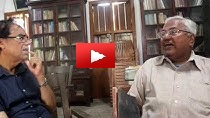 |
| 113 | Dr. Thomas Kalayil, CMI, speaks On "Sagdinan Mar," the Christological hymn Note Dr. Thomas Kalayil’s take on the semantics of the phrase, “d’la pulaga” in the famous Christological chant “Sagdinan mar” is interesting. He thinks that “without division” is not relevant. Fr. Kalayil also draws attention to the many such theological hymns that did not see the light in Malayalam translation. Those treasures continue to be buried in Syriac poetry. Reference: http://christianmusicologicalsocietyo... Joseph J. Palackal, CMINew York 13 December 2018 |
8:13 | 1 Aug , 2018 Library of Sacred Heart Monastry, Chettipuzha, Kerala |
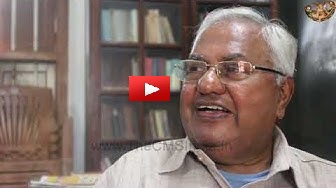 |
| 112 | The Two Founders of the CMI Congregation? Note: This conversation is a corrective to the current narrative about the origin of the CMI Congregation. We are lucky to have Rev. Dr. Thomas Kalayil, CMI, a retired professor at Dharmaram Vidya Kshethram. The conversation is based on historical documents that highlight the role of Palackal Thoma Malpan (circa 1780-1841) and Porukkara Thoma Malpan (1800-1846) in the founding of a new religious congregation in India. Both venerable priests were personal friends, yet had different ideas about the nature and goal of religious life. Because of their sanctity, they ironed out their differences and went to seek permission from the Bishop (Maurilius Stabilini, 1777-1857), who advised them to take a different route. The fact is that these two holy priests are the original founding fathers. That fact was well known and celebrated a hundred years during the centenary celebration of the Congregation, in 1931. In the 1950s, however, the narrative changed to expedite the canonization process of Saint Kuriakose Elias Chavara (1805-1871), a protégé of Palackal Thoma Malpan. Fr. Kalayil, an intellectually honest scholar, was candid when he said that the CMI leaders “manipulated” historical facts to serve their goals. We thank Dr. Kalayil for his honest appraisal. We hope this will help future historians of the CMI Congregation. See also https://youtu.be/a9_wtAs3WNs Joseph J. Palackal CMINew York 13 December 2018 |
1 Aug , 2018 Library of Sacred Heart Monastry, Chettipuzha, Kerala |
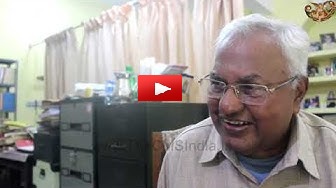 |
|
| 111 | Turgama (interpretative song): Fr Cyril Thayyil and Fr Joseph Kizhakkekkutt
Fr. Cyril Thayyil and Fr. Joseph Kizhakkekkutt sing the Turgama during Raza. Recorded on 28 July 2018. Note: Turgama (literally, “interpretation,” “translation”) is one of the popular poetic genres in Syriac literature. The Turgama we listen here is from Raza, the most solemn celebration of Qurbana in the Syro Malabar tradition. The servers and the choir sing the turgamma antiphonally. The purpose is to prepare the faithful to listen to the Gospel. In the opening verse of the song, the servers address the “faithful” (O dam haimnee), asking them to prepare their hearts so that Jesus can sow the seeds of Good News. The word “turgama” has a connection to the Malayalam-speaking people of Kerala, irrespective of their religious affiliation. The word is part of the Malayalam vocabulary with a modified pronunciation, from തുർഗാമ to തർജമ (tarjama), meaning, “translation.” It is an example of intra-cultural borrowing. In this recording, we hear the Turgamma in the voice of two young and talented singing priests, Fr. Cyril Thayyil and Fr. Joseph Kizhakkekkutt. Both priests are literate in Syriac and use their musical talents to celebrate the solemn sung Qurbana in the Syro Malabar churches. We are grateful to these priests for granting permission to post this recording on our channel. See another use of the word in reference to Aramaic translation of the Hebrew Bible: https://en.wikipedia.org/wiki/Targum Joseph J. Palackal |
5:08 | 28 July 2018 St. Mary's Forane Church, Anakkallu, Bharananganam |
 |


